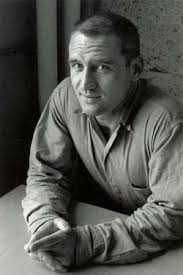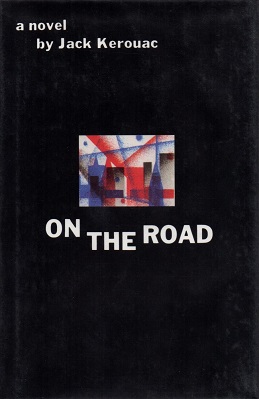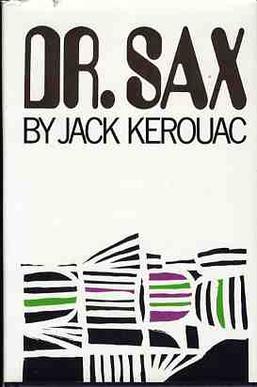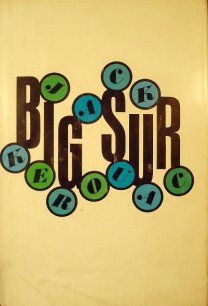
Jean-Louis Lebris de Kérouac, known as Jack Kerouac, was an American novelist and poet who, alongside William S. Burroughs and Allen Ginsberg, was a pioneer of the Beat Generation.

Neal Leon Cassady was a major figure of the Beat Generation of the 1950s and the psychedelic and counterculture movements of the 1960s.

On the Road is a 1957 novel by American writer Jack Kerouac, based on the travels of Kerouac and his friends across the United States. It is considered a defining work of the postwar Beat and Counterculture generations, with its protagonists living life against a backdrop of jazz, poetry, and drug use. The novel is a roman à clef, with many key figures of the Beat movement, such as William S. Burroughs, Allen Ginsberg, and Neal Cassady represented by characters in the book, including Kerouac, himself, as the narrator, Sal Paradise.

Visions of Cody is an experimental novel by Jack Kerouac. It was written in 1951–1952, and though not published in its entirety until 1972, it had by then achieved an underground reputation. Since its first printing, Visions of Cody has been published with an introduction by Beat poet Allen Ginsberg titled "The Visions of the Great Rememberer."

Vanity of Duluoz: An Adventurous Education, 1935–46 is a 1968 semi-autobiographical novel by Jack Kerouac. The book describes the adventures of Kerouac's alter ego, Jack Duluoz, covering the period of his life between 1935 and 1946. The book includes reminiscences of the author's high school experiences in Lowell, Massachusetts, his education at Columbia University, and his subsequent naval service during World War II. It culminates with the beginnings of the beat movement. It was Kerouac's last work published during his life. The tone of the book has been noted for its stark contrast to On the Road.

Lewis Barrett Welch Jr. was an American poet associated with the Beat generation literary movement.

The Subterraneans is a 1958 novella by Beat Generation author Jack Kerouac. It is a semi-fictional account of his short romance with Alene Lee (1931–1991), an African-American woman, in Greenwich Village, New York. It was the first work of Kerouac’s to be released following the success of On the Road. The Subterraneans and its following novel,The Dharma Bums, both proved to be popular when released in 1958, and are now seen as important works of the Beat Literature. A Hollywood film adaptation would be released in 1960.

Desolation Angels is a semi-autobiographical novel written by Beat Generation author Jack Kerouac, which makes up part of his Duluoz Legend. It was published in 1965, but was written years earlier, around the time On the Road was in the process of publication. The events described in the novel take place from 1956-1957. Much of the psychological struggle which the novel's protagonist, Jack Duluoz, undergoes in the novel reflects Kerouac's own increasing disenchantment with the Buddhist philosophy. Throughout the novel, Kerouac discusses his disenchantment with fame, and complicated feelings towards the Beat Generation. He also discusses his relationship with his mother and his friends such as Allen Ginsberg, Neal Cassady, Lucienn Carr and William S. Burroughs. The novel is also notable for being a relatively positive portrayal of homosexuality and homosexual characters, despite its use of words that were at the time considered homophobic slurs.

Visions of Gerard is a novel by American Beat writer Jack Kerouac. Kerouac wrote it over the course of the first two weeks of 1956, while staying with his sister Caroline in Rocky Mount, North Carolina, and it was published in 1963. It is the first volume in Kerouac's "Duluoz Legend". Visions of Gerard focuses on the scenes and sensations of childhood as evidenced in the short yet happy life of his older brother, Gerard. Kerouac paints a picture of the boy as a saint, who loves all creatures and teaches this doctrine to four-year-old Jack. Set in Kerouac's hometown of Lowell, Massachusetts, it is an exploration of the meaning and precariousness of existence.

Maggie Cassidy is a novel by the American writer Jack Kerouac, first published in 1959. It is a largely autobiographical work about Kerouac's early life in Lowell, Massachusetts, from 1938 to 1939, and chronicles his real-life relationship with his teenage sweetheart Mary Carney. It is unique for Kerouac for its high school setting and teenage characters. He wrote the novel in 1953 but it was not published until 1959, after the success of On the Road (1957).

Doctor Sax is a novel by Jack Kerouac published in 1959. Kerouac wrote it in 1952 while living with William S. Burroughs in Mexico City.
Carolyn Elizabeth Robinson Cassady was an American writer and associated with the Beat Generation through her marriage to Neal Cassady and her friendships with Jack Kerouac, Allen Ginsberg, and other prominent Beat figures. She became a frequent character in the works of Jack Kerouac.
William Cannastra was a member of the early Beat Generation scene in New York. He was a "wild man" figure that the writers in the group found interesting, similar to their fascination with Neal Cassady. Characters based on Bill Cannastra were included in both the John Clellon Holmes novel Go and Jack Kerouac's Visions of Cody. He is also described in Allen Ginsberg's "Howl".
Jack Kerouac was an American novelist and poet. He is considered a literary iconoclast and, alongside William S. Burroughs and Allen Ginsberg, a pioneer of the Beat Generation. Kerouac is recognized for his method of spontaneous prose. Thematically, his work covers topics such as Catholic spirituality, jazz, promiscuity, Buddhism, drugs, poverty, and travel. Kerouac used the name "Duluoz Legend" to refer to his collected autobiographical works.
Justin W. Brierly was an American educator and lawyer. Born to a Colorado pioneer family and educated at Columbia and the University of Denver Law School, he was noted in his work in secondary education for his efforts to place students into prominent universities, and as a patron of the performing arts in Colorado. He is also remembered for his association with Beat Generation icons Neal Cassady and Jack Kerouac.

Move Under Ground is a horror novel mashup by American writer Nick Mamatas, which combines the Beat style of Jack Kerouac with the cosmic horror of H. P. Lovecraft's Cthulhu Mythos. It is available as a free download via a Creative Commons license, CC BY-NC-ND 2.5 according to the License information in the CC version of the book.

Big Sur is a 2013 adventure drama film written and directed by Michael Polish. It is an adaptation of the 1962 novel of the same name by Jack Kerouac.

The Beat Museum is located in San Francisco, California and is dedicated to preserving the memory and works of the Beat Generation.
Al Hinkle was a childhood friend of Beat Generation icon Neal Cassady who was the inspiration for the character of Ed Dunkel in Jack Kerouac’s On the Road. In December 1948 Hinkle contributed $100 to the down payment on the 1949 Hudson automobile that Cassady drove across the United States, the journey memorialized in Kerouac’s novel. He was also the real life inspiration for characters in two other Kerouac books: Slim Buckle in Visions of Cody and Ed Buckle in Book of Dreams.
Haldon Chase, often referred to as "Hal Chase", was a Denver-born archaeologist, who was known for his archaeological research on several rock art sites at Colorado. Outside the field of archaeology, he was best known as part of the earliest Beat circle.












